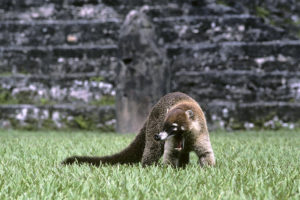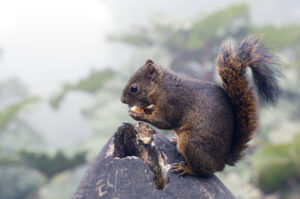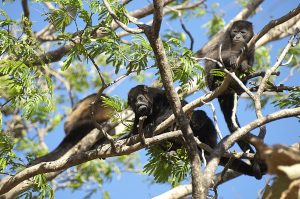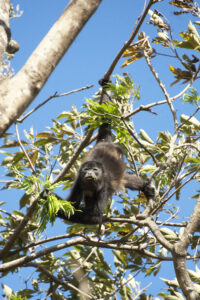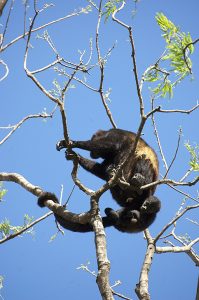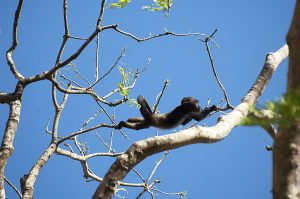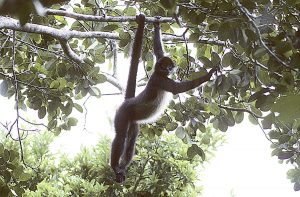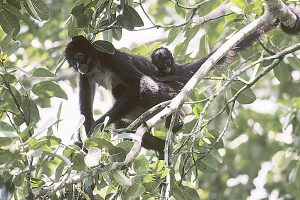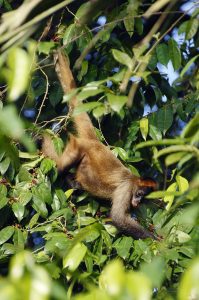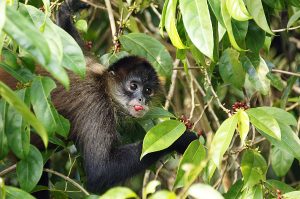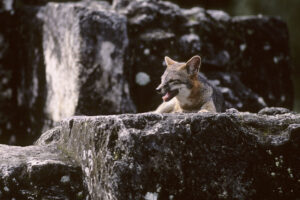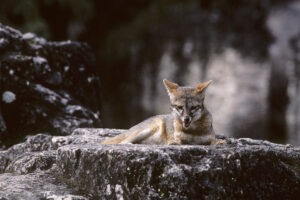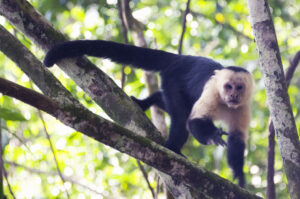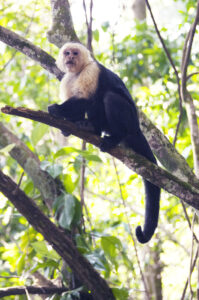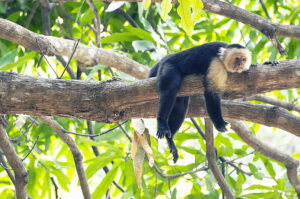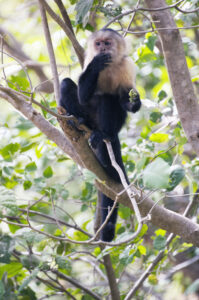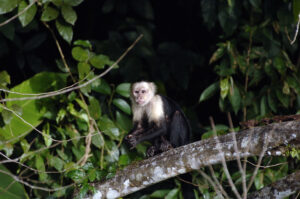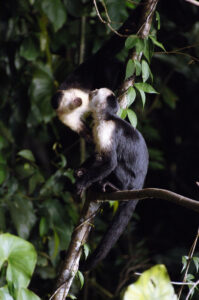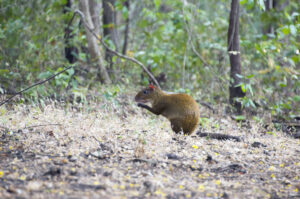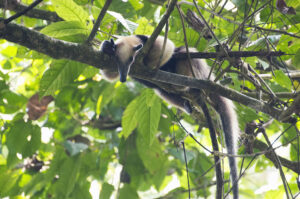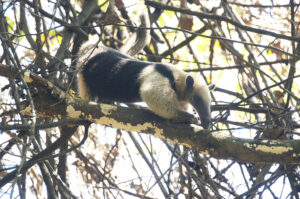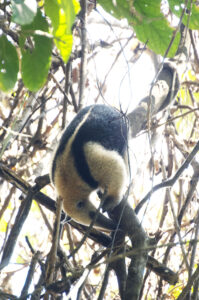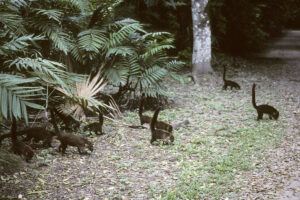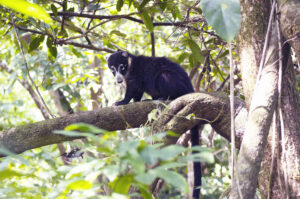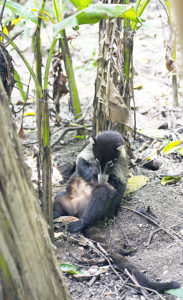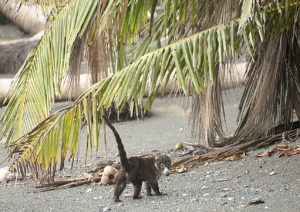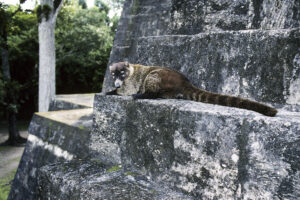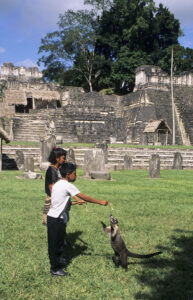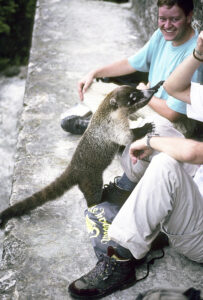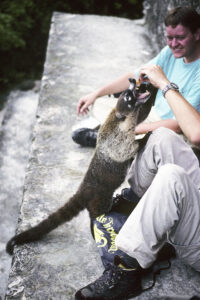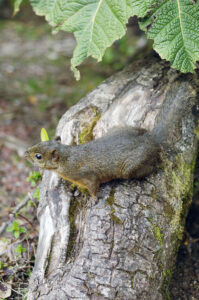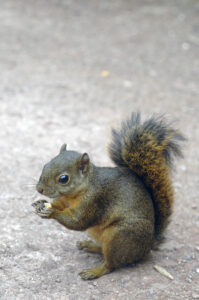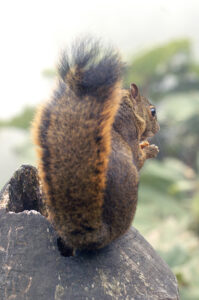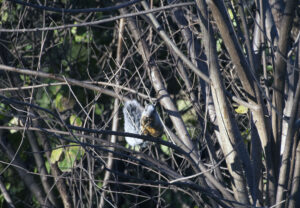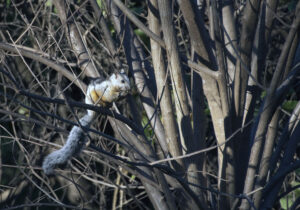Mammals in Costa Rica and Guatemala
The white-nosed coati (Nasua narica) is common and confiding among the Mayan ruins of Tikal National Park, Guatemala. (Photo copyright © by Kaj Halberg)
A tiny young golden-mantled howler monkey (Alouatta palliata ssp. palliata) clings to its mother’s tail, Bagaces, Guanacaste, Costa Rica. (Photo copyright © by Kaj Halberg)
A red-tailed squirrel (Sciurus granatensis), eating nuts at a viewing platform for tourists, Volcán Poás National Park, Cordillera Central, Costa Rica. (Photos copyright © by Kaj Halberg)
This page deals with a selection of mammals, which I encountered during a 7 week long stay in Guatemala October-November 1998, and a one month long stay in Costa Rica January-February 2012. Families, genera, and species are presented in alphabetical order.
In case you find any errors, I would be grateful to receive an email. You may use the address at the bottom of this page.
Atelidae Spider monkeys, howler monkeys, and woolly monkeys
This family of New World monkeys contains 4 genera with about 26 species, living in forests from Mexico southwards to northern Argentina.
Alouatta Howler monkeys
These monkeys constitute a group of 15 species, distributed from south-eastern Mexico southwards to northern Argentina. They live in various types of forest, including mangrove and swamp forest. Threats to these monkeys include habitat destruction and human persecution for food, for the pet industry, and for zoos.
Howler monkeys are famous for their loud call, which can be heard almost 5 km away. They have an enlarged hyoid bone, which enables them to produce this incredibly loud noise. The main function of the howling is probably to guard the territory of the troop.
The generic name is a corruption of arawata, the Carib name of the Venezuelan red howler monkey (A. seniculus).
Alouatta palliata Mantled howler monkey
Comprising 5 subspecies, this monkey is widespread, distributed from south-eastern Mexico southwards to northern Peru. The golden-mantled howler monkey, subspecies palliata, is quite dark, with a rufous mantle along the sides, and a golden patch on the back. It ranges from extreme eastern Guatemala eastwards to eastern Costa Rica. It mainly lives in the lowland, occasionally found up to 2,000 m altitude.
The specific name is derived from the Latin pallium, a large cloak, worn by Greek philosophers. In this case, it refers to the tuft of long hairs on the sides of this animal.
Golden-mantled howler monkeys, feeding in a tree, near Bagaces, Guanacaste. (Photos copyright © by Kaj Halberg)
A tiny young clings to its mother’s tail, Bagaces. (Photo copyright © by Kaj Halberg)
A slightly larger young already shows great agility. (Photo copyright © by Kaj Halberg)
Ateles Spider monkeys
Spider monkeys are a genus of 7 species, found from southern Mexico southwards to Brazil, living in the upper stratum of tropical forests. These monkeys are characterized by their disproportionately long limbs, which have given them their name, and their long, prehensile tail, which is used as a fifth limb. They live in bands, comprising up to 35 members, which will disperse during the day to feed.
All species of spider monkeys are threatened due to habitat destruction and hunting for food, and two species, the black-headed (A. fusciceps) and the brown (A. hybridus), are critically endangered.
The generic name is derived from Ancient Greek ateleia (‘incomplete’ or ‘imperfect’), alluding to the reduced or non-existent thumbs of these monkeys.
Ateles geoffroyi Geoffroy’s spider monkey
This monkey, also called black-handed or Central American spider monkey, has 5 or 6 subspecies, distributed from south-eastern Mexico eastwards to Panama. It mainly occurs in evergreen rainforest, but may also be found in deciduous forest. The species is threatened due to habitat loss, which has been severe across its entire range. It is estimated that it has declined by as much as 50% during the last 50 years. Today, it mainly survives in protected areas.
Spider monkeys of the Yucatan Peninsula and northern Guatemala are variously treated as belonging to subspecies vellerosus or yucatanensis, the latter now discarded by a number of authorities, whereas animals from northern Costa Rica, known as the red spider monkey, belong to subspecies ornatus. This subspecies is illustrated at the top of this page.
The specific name was given in honour of French naturalist Étienne Geoffroy Saint-Hilaire (1772-1844).
Yucatan spider monkey, using its tail as a fifth limb, Tikal National Park, Guatemala. (Photo copyright © by Kaj Halberg)
A young Yucatan spider monkey clings to its mother’s back, Tikal National Park. (Photo copyright © by Kaj Halberg)
These red spider monkeys are feeding on coffee-like fruits, Tortuguero National Park, Limón, Costa Rica. (Photos copyright © by Kaj Halberg)
Canidae Dog family
This family, comprising about 35 species, includes domestic dogs, wolves, jackals, hunting dogs, foxes, and many other dog-like animals. About 50 million years ago, a group of carnivores split into two groups, the cat-like Feliformia and the dog-like Caniformia.
The latter evolved into a large number of families, of which the Canidae, about 12 mio. years ago, split into three groups:
Canini includes wolf-like dogs, and South American dogs and foxes.
Vulpini includes typical foxes, bat-eared fox (Otocyon megalotis), and raccoon dog (Nyctereutes procyonoides).
Urocyon (see below).
Urocyon Grey foxes
Genetic research indicates that the two foxes of this genus belong to an ancient lineage, which split out at a very early stage (Lindblad-Toh et al. 2005). Modern taxonomists do not include them in Canini or Vulpini.
The genus includes the grey fox (below) and the island fox (U. littoralis), the latter restricted to 6 of the 8 Californian Channel Islands.
The generic name is derived from Ancient Greek oura (‘tail’) and kyon (‘dog’), thus ‘tailed dog’ – a strange name for dogs, most of which have long, bushy tails.
Urocyon cinereoargenteus Grey fox
This species is widely distributed, from southern Canada southwards through the United States, Mexico, and Central America to Columbia and Venezuela.
The specific name is Latin, meaning ‘of ashes and silver’, i.e. ‘ash- and silver-coloured’.
The grey fox is common among the Mayan ruins of Tikal National Park, Guatemala. (Photo copyright © by Kaj Halberg)
Cebidae Capuchin monkeys and squirrel monkeys
Following a number of genetic studies, this formerly large family has now been reduced to 3 genera with about 29 species, found from Mexico southwards to northern Argentina.
Cebus Capuchin monkeys
This genus, comprising about 15 species, is distributed from Honduras southwards to Peru and Brazil.
The generic name is derived from Ancient Greek kebos, the term for a kind of long-tailed monkey.
The word capuchin derives from a group of Franciscan friars, named the Order of Friars Minor Capuchin, which arose in 1520, when Italian friar Matteo da Bascio claimed that God had informed him that the manner of life led by his contemporary friars was not the one, which St. Francis of Assisi had dictated. The friars of this order wear brown robes with pointed hoods, called capuche. When the conquistadors reached Central America late in the 15th Century, they noticed some small monkeys, whose colouring resembled these friars, so they named them capuchins. (Source: en.wikipedia.org/wiki/Capuchin_monkey)
Cebus imitator Central American white-faced capuchin
This species is native to forests of Honduras, Nicaragua, Costa Rica, and western Panama. It is quite common in Costa Rica, living in a varity of forest types, and it is often confiding.
In the West, it is one of the best known of all monkeys, as it was often the faithful companion of the organ grinder, who would walk from town to town, playing his organ, while his monkey would perform a dance.
Until recently, this animal was considered conspecific with the Columbian white-headed capuchin (C. capucinus), which is found in coastal areas from eastern Panama southwards to Ecuador.
Central American white-faced capuchin, biting off bark in search of food, Corcovado National Park, Peninsula de Osa. (Photos copyright © by Kaj Halberg)
White-faced capuchin, resting on a branch, Palo Verde National Park, Guanacaste. (Photo copyright © by Kaj Halberg)
This one is stuffing its mouth with fruit, Palo Verde National Park. (Photo copyright © by Kaj Halberg)
White-faced capuchin, feeding on fruits of a tree, Tortuguero National Park, Limón. (Photos copyright © by Kaj Halberg)
Grooming white-faced capuchins, Tortuguero National Park. (Photo copyright © by Kaj Halberg)
Dasyproctidae
A small family of rather large Latin American rodents, comprising the genera Dasyprocta (below), and Myoprocta, with 2 species.
Dasyprocta Agoutis
This genus contains about about 11 species, found from southern Mexico southwards to north-western Argentina. They are among the larger rodents, being up to 75 cm long and weighing up to 6 kg.
The generic name is derived from Ancient Greek dasus (‘hairy’) and proktos (‘anus’). The common name stems from a native language, either Guarani or Tupi.
Dasyprocta punctata Central American agouti
This animal is found from southern Mexico southwards to Columbia and Ecuador, with a disjunct population in south-eastern Peru, south-western Brazil, Bolivia, western Paraguay, and north-western Argentina. This population is variably treated as a subspecies of the Central American agouti, or a separate species, D. variegata. It has also been introduced to Cuba and the Cayman Islands.
The specific name may refer to its pelt, which has mingled yellowish and black hairs, giving the animal a ‘punctuated’ appearance.
Central American agouti, Tikal National Park, Guatemala. (Photo copyright © by Kaj Halberg)
When running, an agouti looks rather like a small deer, not at all like a rodent. – Tikal National Park. (Photo copyright © by Kaj Halberg)
Feeding Central American agouti, Palo Verde National Park, Guanacaste, Costa Rica. (Photo copyright © by Kaj Halberg)
Myrmecophagidae Anteaters
A small family of 3 species, the giant anteater (Myrmecophaga tridactyla), and two species of Tamandua, the northern tamandua (below) and the southern (T. tetradactyla). They are found from southern Belize and Guatemala southwards to northern Argentina.
The family name is derived from Ancient Greek myrmekos, genitive of myrmex (‘ant’), and ephagon (‘to eat’).
Tamandua mexicana Northern tamandua
This rather small anteater is distributed from southern Mexico southwards to Columbia, western Venezuela, coastal Ecuador, and extreme northern Peru.
The generic name is the Tupi-Guarani word for these animals.
A northern tamandua is sprawled along a branch, sleeping comfortably (top), whereas another is busy searching for termites, Corcovado National Park, Peninsula de Osa, Costa Rica. (Photos copyright © by Kaj Halberg)
Procyonidae Raccoons and allies
This New World family of carnivores, comprising 6 genera with altogether 14 species, is distributed from central Canada southwards to Argentina and Uruguay.
Nasua Coatis
Coatis are characterized by their long, highly mobile snout. Indeed, their generic name is derived from the Latin nasus, meaning ’nose’. There are 4 species, two of which belong to this genus, the white-nosed (below), and the South American (N. nasua). They occur from south-western United States southwards to northern Argentina and Uruguay.
Two other coatis are placed in the genus Nasuella.
Coatis are very social, living in bands counting up to 30 animals, consisting of females with offspring. Adult males usually live alone. Previously, biologists presumed that all females in a band were blood-related, because a female will often take care of the offspring of another female, allowing her to feed freely. However, research has shown that not all females in a group are blood-related. Some unrelated females simply form a friendship, and these friends are so well trusted that a female will often let her friend take care of her young, while she is out feeding. This behaviour also allows a female to bring her young into the band from her nest much earlier than she could otherwise have done, because other females will guard her young.
For a short period of time each year, a male coati will join a band to mate with as many females as possible. But as males are known to often kill and eat young coatis, the females soon become aggressive and chase him away from the band. When a mother brings her newborn young into a band, the male will re-join the group for a short period, sniffing all the young he has fathered, thus being able to recognize them later and avoid eating his own offspring!
Nasua narica White-nosed coati
This animal lives in a variety of habitats, from desert to rain forest, distributed from Arizona and New Mexico southwards to north-western Columbia. It is quite common in Costa Rica.
It is described in depth on the page Animals – Mammals: Long-nosed coatis – charming bandits.
The specific name is derived from the Latin naris (‘nasal cavity’).
Coati bands may contain up to 30 animals. – Tikal National Park, Guatemala. (Photo copyright © by Kaj Halberg)
White-nosed coati, Corcovado National Park, Peninsula de Osa, Costa Rica. (Photo copyright © by Kaj Halberg)
Grooming white-nosed coati, Corcovado National Park. (Photo copyright © by Kaj Halberg)
This white-nosed coati was walking on the beach in front of us for a long time, Corcovado National Park. (Photo copyright © by Kaj Halberg)
The white-nosed coati is common and confiding among the Mayan ruins of Tikal National Park. (Photos copyright © by Kaj Halberg)
In Tikal National Park, my fellow traveller Lotte Møller Pedersen has got company of a white-nosed coati. (Photo copyright © by Kaj Halberg)
Thirty seconds after these pictures were taken, the coati was sprinting down the slope, carrying a bag in its mouth. – Tikal National Park. (Photos copyright © by Kaj Halberg)
Sciuridae Squirrels
A huge family with about 51 genera and c. 300 species, distributed in the major part of the Americas, Eurasia, and Africa. Some species have also been introduced to Australia.
The family name is derived from Sciurus, the Latin name applied by Swedish naturalist Carl Linnaeus (1707-1778) in 1758 to the Eurasian red squirrel (S. vulgaris). The word squirrel, which has been in use as early as 1327, is from the Anglo-Norman name esquirel, which is again from the Old French escurel, a corruption of the Latin sciurus, which is derived from Ancient Greek skia (‘shadow’) and oura (‘tail’), thus ‘shadow-tailed’, alluding to the habit of some squirrels to raise their bushy tails over the body, thus creating shade.
Many species of squirrel are presented on the page Animals – Mammals: Squirrels.
Sciurus
A large genus with about 30 species, distributed in Europe, temperate areas of Asia, and the entire Americas.
An extensive genetic study from 2020 (Abreu et al. 2020) concludes that the genus is paraphyletic and should be split into 11 or 12 genera, leaving only 3 species in Sciurus. However, this suggestion has not been widely accepted, and for the time being I retain the older concept of the genus.
Sciurus granatensis Red-tailed squirrel
A common species, found from Costa Rica eastwards to Venezuela, and thence southwards to Ecuador, and also on the Caribbean islands Margarita and Trinidad & Tobago.
This animal lives in various types of forest, from sea level to an elevation of about 3,000 m. It is confiding and often occurs in picnic grounds.
The specific name refers to a Spanish enclave named Virreinato de Nueva Granada (‘The Viceroyalty of New Granada’) – an area, which in the 1700s covered present-day Panama, Columbia, Venezuela, and Ecuador.
Red-tailed squirrels, eating nuts at a viewing platform for tourists, Volcán Poás National Park, Cordillera Central, Costa Rica. (Photos copyright © by Kaj Halberg)
Sciurus variegatoides Variegated squirrel
A common species, native from Mexico eastwards through Central America to Panama. Habitats include forest, secondary growth, and plantations, from the lowland up to an altitude of about 1,800 m. It is sometimes a pest in crops.
As the specific and popular names imply, the coat of this species varies considerably, not only between the 15 subspecies, but also between individuals in the same population.
Variegated squirrel, Bagaces, Guanacaste, Costa Rica. (Photos copyright © by Kaj Halberg)
(Uploaded May 2023)
